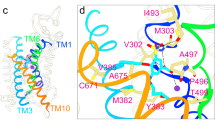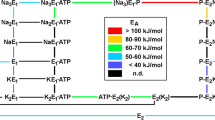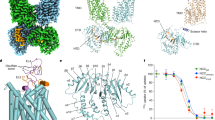Summary
The inactivation of the rabbit parotid Na/K/Cl cotransporter by the irreversible sulfhydryl reagent N-ethylmaleimide (NEM) is studied by monitoring its effect on high affinity bumetanide binding to the carrier. NEM reduces the number of bumetanide binding sites with no significant change in the affinity of those remaining. NEM also reduces KCl-dependent22Na flux via the cotransporter by the same factor as the reduction in bumetanide binding sites. Both bumetanide and its analogue furosemide can protect against the effect of NEM. The concentration range over which this protection occurs is in good agreement with affinities of these two compounds for the high affinity bumetanide binding site (2.6 and 85 μm, respectively), indicating an association of this site with the site of action of NEM. Also consistent with this hypothesis are the observations that (i) sodium and potassium, both of which are required for high affinity bumetanide binding, increase the rate of inactivation of binding by NEM and (ii) chloride, at concentrations previously shown to competitively inhibit bumetanide binding, protects the cotransporter against NEM. The effects of NEM on bumetanide binding are mimicked by another highly specific sulfhydryl reagent, methyl methanethiolsulfonate. The apparent rate constant for inactivation of high affinity bumetanide binding by NEM is a hyperbolic function of NEM concentration consistent with a model in which the inactivation reaction is first order in [NEM] and proceeds through an intermediate adsorptive complex. The data indicate that the presence of a reduced sulfhydryl group at or closely related to the bumetanide binding site is essential for the operation of the parotid Na/K/Cl cotransporter.
Similar content being viewed by others
References
Brewer, C.F., Riehm, J.P. 1967. Evidence for possible nonspecific reactions between N-ethylmaleimide and proteins.Anal. Biochem. 18:248–255
Brocklehurst, K. 1979. The equilibrium assumption is valid for the kinetic treatment of most time-dependent protein modification reactions.Biochem. J. 181:775–778
Brown, C.D.A., Murer, H. 1985. Characterization of a Na∶K∶2Cl cotransport system in the apical membrane of a renal epithelial cell line (LLC-PK1).J. Membrane Biol. 87:131–139
Burnham, C., Karlish, S.J.D., Jorgensen, P.L. 1985. Identification and reconstitution of a Na/K/Cl cotransporter and K channel from luminal membranes of renal outer medulla.Biochim. Biophys. Acta 821:461–469
Elferink, M.G.L., Hellingwerf, K.J., Van Dijl, J.M., Robillard, G.T., Poolman, P., Konings, W.N. 1985.Ann. N.Y. Acad. Sci. 456:361–374
Feit, P.W., Hoffmann, E.K., Schiodt, M., Kristensen, P., Jessen, F., Dunham, P.B. 1988. Purification of proteins of the Na/Cl cotransporter from membranes of Ehrlich ascites cells using a bumetanide-sepharose affinity column.J. Membrane Biol. 103:135–147
Geck, P., Heinz, E. 1986. The Na-t-K−2Cl cotransport system.J. Membrane Biol. 91:97–105
Haas, M., McManus, T.J. 1983. Bumetanide inhibits (Na+K+2Cl) co-transport at a chloride site.Am. J. Physiol. 245:C235-C240
Hass, M., Forbush, B. 1987. Na, K, Cl-cotransport system: Characterization by bumetanide binding and photolabelling.Kidney Int. 32:S134-S140
Jorgensen, P.L., Petersen, J., Rees, W.D. 1984. Identification of a Na, K, Cl cotransport protein ofM r 34,000 from kidney by photolabeling with [3H]-bumetanide.Biochim. Biophys. Acta 775:105–110
Kinne, R., Hannafin, J.A., Konig, B. 1985. Role of the NaCl−KCl cotransport system in active chloride absorption and secretion. Ann. N.Y. Acad. Sci.456:198–206
Kinne, R., Kinne-Saffran, E., Scholermann, B., Schutz, H. 1986. The anion specificity of the sodium-potassium-chloride cotransporter in rabbit kidney outer medulla: Studies on medullary plasma membranes.Pfluegers Arch. 407:S168-S173
Kitz, R., Wilson, I.B. 1962. Esters of methanesulfonic acid as irreversible inhibitors of acethylcholinesterase.J. Biol. Chem. 237:3245–3247
Konings, W.N., Robillard, G.T. 1981. Physical mechanism for regulation of proton solute symport inEscherichia coli.Proc. Natl. Acad. Sci. USA 79:5480–5484
Malcolm, A.D.B., Radda, G.K. 1970. The reaction of glutamate dehydrogenase with 4-iodoacetamido salicylic acid.Eur. J. Biochem. 15:555–561
Martinez, J.R. 1987. Ion transport and water movement.J. Dent. Res. 66:638–647
Melvin, J.E., Kawaguchi, M., Baum, B.J., Turner, R.J. 1987. A muscarinic agonist-stimulated chloride efflux pathway is associated with fluid secretion in rat parotid acinar acid.Biochem. Biophys. Res. Commun. 145:754–759
Nauntofte, B., Poulsen, J.H. 1986. Effects of Ca2+ and furosemide on Cl− transport and O2 uptake in rat parotid acini.Am. J. Physiol. 251:C175-C185
Novak, I., Young, J.A. 1986. Two independent anion transport systems in rabbit mandibular salivary glands.Pfluegers Arch. 407:649–656
O'Grady, S.M., Palfrey, H.C., Field, M. 1987. Characteristics and functions of Na−K−Cl cotransport in epithelial tissues.Am. J. Physiol. 253:C177-C192
Palfrey, H.C., Rao, M.C. 1983. Na/K/Cl cotransport and its regulation.J. Exp. Biol. 106:43–54
Pirani, D., Evans, A.R., Cook, D.I., Young, J.A. 1987. Intracellular pH in the rat mandibular salivary gland: The role of Na−H and Cl−HCO3 anitports in secretion.Pfluegers Arch. 408:178–184
Smith, D.J., Maggio, E.T., Kenyon, G.L. 1975. Simple alkanethiol groups for temporary blocking of sulfhydryl groups of enzymes.Biochemistry 14:766–771
Smyth, D.G., Blumenfeld, O.O., Konigsberg, W. 1964. Reactions of N-ethylmaleimide with peptides and amino acids.Biochem. J. 91:589–595
Turner, R.J., George, J.N. 1984. Characterization of an essential disulfide bond associated with the active site of the renal brush-border membraned-glucose transporter.Biochim. Biophys. Acta 769:23–32
Turner, R.J., George, J.N. 1988. Ionic dependence of bumetanide binding to the rabbit parotid Na/K/Cl cotransporter.J. Membrane Biol. 102:71–77
Turner, R.J., George, J.N., Baum, B.J. 1986. Evidence for a Na+/K+/Cl− cotransport system in basolateral membrane vesicles from the rabbit parotid.J. Membrane Biol. 94:143–152
Young, J.A., Cook, D.I., van Lennep, E.W., Roberts, M.L. 1987. Secreation by the major salivary glands.In: Physiology of the Gastrointestinal Tract. (2nd ed.) L. Johnson et al., editors. Raven, New York
Author information
Authors and Affiliations
Rights and permissions
About this article
Cite this article
George, J.N., Turner, R.J. Inactivation of the rabbit parotid Na/K/Cl cotransporter by N-ethylmaleimide. J. Membrain Biol. 112, 51–58 (1989). https://doi.org/10.1007/BF01871163
Received:
Issue Date:
DOI: https://doi.org/10.1007/BF01871163




